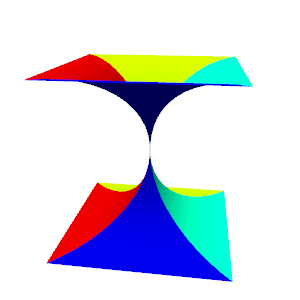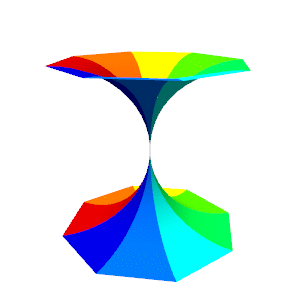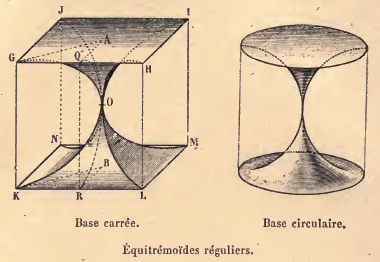use OpenGL;
#7 Equitremoid
This program draws an Equitremoid.
An equitremoid is another solid defined by Léopold Hugo.
It consists also of cylindrical wedges as equidomoid but of inverted concavity.
More on Léopold Hugo:
La riforma geometrica di Leopold Hugo (in Italian).
Equitremoid of order 4, 8 and 32:




Figures from Émile Fourrey -
Curiosités géométriques (Paris 1910)
tremoid.pl
#!/usr/local/bin/perl
#
# tremoid.pl : draw an equitremoid
# (c) 2013 jl_morel@bribes.org - http://http://bribes.org/perl
use strict;
use warnings;
use Math::Trig;
use OpenGL qw/ :all /;
my $n = 8; # equitremoid order
my $scale = 2.6; # image scale
#------ Base vectors
my @i = ( 1, 0, 0 );
my @j = ( 0, 1, 0 );
my @k = ( 0, 0, 1 );
my @O = ( 0, 0, 0 );
#------ Draw a Cylindrical Wedge
sub DrawWedge {
my $n = shift;
# Setup the quadric object
my $qd = gluNewQuadric();
gluQuadricDrawStyle( $qd, GLU_FILL );
gluQuadricNormals( $qd, GLU_SMOOTH );
gluQuadricOrientation( $qd, GLU_OUTSIDE );
gluQuadricTexture( $qd, GL_FALSE );
# The cylinder is cut with three plans to get a wedge
glPushMatrix();
glClipPlane_p( GL_CLIP_PLANE0, -sin( pi / $n ), 0, -cos( pi / $n ), 0 );
glEnable(GL_CLIP_PLANE0);
glClipPlane_p( GL_CLIP_PLANE1, -sin( pi / $n ), 0, cos( pi / $n ), 0 );
glEnable(GL_CLIP_PLANE1);
glClipPlane_p( GL_CLIP_PLANE2,, 1, 0, 0, 1 );
glEnable(GL_CLIP_PLANE2);
glTranslatef( -1, 0, -2 );
gluCylinder( $qd, 1, 1, 4, 50, 1 );
glDisable(GL_CLIP_PLANE0);
glDisable(GL_CLIP_PLANE1);
glDisable(GL_CLIP_PLANE2);
glPopMatrix();
}
#------ Draw the equitremoid of order n
sub DrawEquitremoid {
my $n = shift;
for ( 0 .. $n - 1 ) {
glRotatef( rad2deg( 2 * pi / $n ), @j );
glColor3f( Rainbow( $_ / ( $n - 1 ) ) );
DrawWedge($n);
}
}
#------ Draw the bounding prism
sub DrawPrism {
my $n = shift;
my $r = 1 / cos( pi / $n );
my @alpha = map { ( 2 * $_ + 1 + $n % 2 ) * pi / $n } ( 0 .. $n - 1 );
glColor3f( 0.8, 0.8, 0.8 ); # gray
glBegin(GL_LINE_LOOP); # bottom
glVertex3f( $r * cos($_), -1, $r * sin($_) ) foreach @alpha;
glEnd();
glBegin(GL_LINE_LOOP); # up
glVertex3f( $r * cos($_), 1, $r * sin($_) ) foreach @alpha;
glEnd();
glBegin(GL_LINES); # edges
foreach (@alpha) {
glVertex3f( $r * cos($_), 1, $r * sin($_) );
glVertex3f( $r * cos($_), -1, $r * sin($_) );
}
glEnd();
}
#------ Draw the scene
my $spin = 0;
sub display {
glClear( GL_COLOR_BUFFER_BIT | GL_DEPTH_BUFFER_BIT );
glLoadIdentity();
gluLookAt( 2.0, 4.0, 10.0, 0.0, 0.0, 0.0, 0.0, 1.0, 0.0 );
glPushMatrix();
glScalef( $scale, $scale, $scale );
glRotatef( $spin, @j );
DrawEquitremoid($n);
# DrawPrism($n);
glPopMatrix();
glutSwapBuffers();
# debug code
# if ( ( my $e = glGetError() ) != GL_NO_ERROR ) {
# print "error : ", gluErrorString($e), "\n";
# }
}
#------ GLUT Callback called when the window is resized
sub reshape {
my ( $w, $h ) = @_;
glViewport( 0, 0, $w, $h );
glMatrixMode(GL_PROJECTION);
glLoadIdentity(); # define the projection
gluPerspective( 45, $h ? $w / $h : 0, 1, 20 );
glMatrixMode(GL_MODELVIEW);
glLoadIdentity();
}
#------ Routine for rotating the scene
my $WaitUntil = 0;
sub spinDisplay {
my $TimeNow = glutGet(GLUT_ELAPSED_TIME);
if ( $TimeNow >= $WaitUntil ) {
$spin += 1.0;
$spin = $spin - 360.0 if ( $spin > 360.0 );
glutPostRedisplay();
$WaitUntil = $TimeNow + 1000 / 25; # 25 frames/s
}
}
#------ GLUT callback for the mouse
sub mouse {
my ( $button, $state, $x, $y ) = @_;
if ( $button == GLUT_LEFT_BUTTON ) {
glutIdleFunc( \&spinDisplay ) if ( $state == GLUT_DOWN );
}
elsif ( $button == GLUT_RIGHT_BUTTON ) {
glutIdleFunc(undef) if ( $state == GLUT_DOWN );
}
}
#------ Initialization routine
my @light0_position = ( -2.0, 8.0, 5.0, 0.0 );
my @mat_amb_diff_color = ( 0.8, 0.8, 0.8, 1.0 );
my @light_diffuse = ( 2.0, 2.0, 2.0, 1.0 );
my @light_ambient = ( 0.2, 0.2, 0.2, 1 );
sub init {
glClearColor( 1, 1, 1, 1 ); # White background
glShadeModel(GL_SMOOTH); # Smooth shading
glEnable(GL_MULTISAMPLE); # Enable multisample antialiasing
glEnable(GL_DEPTH_TEST); # Enable hidden surface removal
glEnable(GL_LIGHTING);
glEnable(GL_LIGHT0);
# Light and material
glLightfv_p( GL_LIGHT0, GL_POSITION, @light0_position );
glLightfv_p( GL_LIGHT0, GL_DIFFUSE, @light_diffuse );
glLightfv_p( GL_LIGHT0, GL_AMBIENT, @light_ambient );
glMaterialfv_p( GL_FRONT, GL_AMBIENT_AND_DIFFUSE, @mat_amb_diff_color );
glEnable(GL_COLOR_MATERIAL); # Material track the current color
glLightModeli( GL_LIGHT_MODEL_TWO_SIDE, GL_TRUE );
}
#------ Main
glutInit();
glutInitDisplayMode(
GLUT_DOUBLE # Double buffering
| GLUT_RGB # RGB color mode
| GLUT_DEPTH # Hidden surface removal
| GLUT_MULTISAMPLE # Multisample antialiasing
);
glutInitWindowSize( 300, 300 );
glutCreateWindow("Equitremoid");
init();
glutDisplayFunc( \&display );
glutReshapeFunc( \&reshape );
glutMouseFunc( \&mouse );
glutIdleFunc( \&spinDisplay );
glutMainLoop();
#------ Rainbow color map function
# Usage: ($red, $green, $blue) = Rainbow( $x );
# $x must be between 0 and 1.
# Returns the color of the rainbow (RGB list) associated with $x
# from blue for $x = 0 to red for $x = 1.
sub max { $_[0] < $_[1] ? $_[1] : $_[0] } # max auxiliary function
sub Rainbow {
my $dx = 0.8;
my $s = ( 6 - 2 * $dx ) * $_[0] + $dx;
return max( 0, ( 3 - abs( $s - 4 ) - abs( $s - 5 ) ) / 2 ), # Red
max( 0, ( 4 - abs( $s - 2 ) - abs( $s - 4 ) ) / 2 ), # Green
max( 0, ( 3 - abs( $s - 1 ) - abs( $s - 2 ) ) / 2 ); # Blue
}
The script as .txt for download:
tremoid.pl.txt
Back to Top
BðP © 2013 J-L Morel - Contact : jl_morel@bribes.org
![[Validation HTML 4.0!]](vh401.gif)



